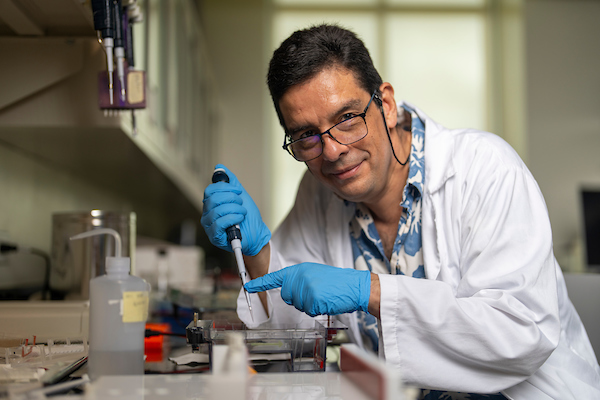Research eyes sustainable future for African fisheries
Genetic study empowers, guides bonytongue conservation in West Africa
Tofunmi Oladimeji wants to make sure future generations of Nigerians can fish for African bonytongue.

Oladimeji, Ph.D., is a former visiting research assistant in the lab of Luis Hurtado, Ph.D., professor and evolutionary biologist in the Texas A&M College of Agriculture and Life Sciences Department of Ecology and Conservation Biology. She came to Hurtado’s lab to learn genetic techniques and analyses that could be used to guide conservation and management of threatened bonytongue populations in inland West African fisheries.
Oladimeji returned to Nigeria after being part of a team of scientists that completed a genetic assessment of African bonytongue populations.
She hopes the data and knowledge generated by the study led by Hurtado, “Critically Small Contemporaneous Effective Population Sizes Estimated for Stocks of the African Bonytongue in Western Africa,” will help guide sustainable conservation of this important fish.
International impact through research
The bonytongue is a fish species with enormous commercial and subsistence fishing value in Africa. But populations of bonytongue have experienced sharp declines due to overfishing and freshwater habitat losses.
Much of the fishing regulations emphasized by Nigeria’s Federal Department of Fisheries are directed at coastal waters, Oladimeji said, while inland waters are fished indiscriminately.
Hurtado’s research included Oladimeji, Alphonse Adite, Ph.D., a former graduate student working now in Benin; other faculty and a postdoctoral researcher in the Department of Ecology and Conservation Biology, as well as faculty from Georgetown University and Nigeria.
“Fish constitute a major part of the diet locally and beyond; hence the conservation and sustainable management of this species should be taken seriously,” Oladimeji said. “I hope the recommendations of this study will help mitigate the impact of unregulated fishing and preserve these fish populations.”
Research identifies biodiversity problem and solutions
Researchers studied populations of 12 African bonytongue populations in Nigeria, Benin and Cameroon. Previous genetic research published by the research team identified that the fish in each location represented a genetically distinct population, Hurtado said.
In this study, researchers estimated the effective population size for these distinct populations to assess their short- and long-term genetic risks of extinction and inform conservation and management strategies for sustainable use.

If their numbers fell below 50, inbreeding could reduce fitness within the isolated genetic pool and contribute to short-term extinction. Unfortunately, they found that nine of the 12 populations were so low that they are at imminent risk of genetic problems that could compromise their survival.
Hurtado said the long-term survival of 11 of the populations is at risk, which means they may have trouble coping with environmental changes, such as habitat loss and climate change. That makes conservation efforts imperative to preserve these unique populations.
The hope is that the situation for these important fish populations can be reversed, Hurtado said. There has been success in fisheries where local leadership took steps to conserve populations and habitat, so the scientists know populations can bounce back.
“This type of conservation takes local action,” Hurtado said. “Dr. Adite and Dr. Oladimeji completed their training here at TAMU and are now acting on the science and utilizing genetic information to guide local leaders and create sustainable plans for these distinct species and fisheries.
“It’s heartening as scientists to see colleagues worldwide providing data and expertise to guide local management decisions to sustain healthy populations into the future.”
Research ripples across globe
Hurtado said collaborative international studies like this are rewarding. They provide teaching and learning opportunities for all scientists involved, and they’re impactful.
The data collected and what Hurtado and the team learned about these 12 bonytongue populations provide insights that can be applied across his work and fields related to biodiversity. The tools and knowledge imparted to Oladimeji and Adite bolsters their ability to lead biodiversity research and conservation efforts in their countries.
Hurtado said the research and genetic tool the team created will help expand the study’s impact to other African nations and beyond. Modeling genetic risks and preparing subsequent recovery plans will ensure sustainable fish populations for future generations to catch and eat.
“We are preparing the scientists and working with them on impactful research,” Hurtado said. “That is good for conservation of local biodiversity, but it also provides them with tools and knowledge they can apply beyond their home country. As a scientist, professor and mentor, that is a gratifying achievement.”





